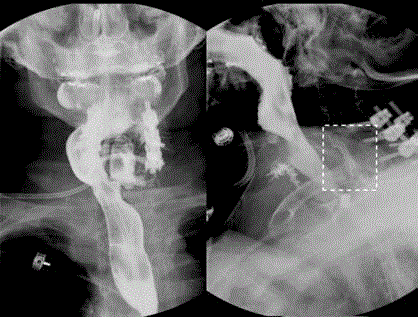Clinical Image
Delayed Presentation of Esophageal Perforation Following Cervical Surgery
Andrew IY*, James AK and William CW
Department of Neurosurgery, University of Pennsylvania Health System, USA
*Corresponding author: Andrew I Yang, Department of Neurosurgery, University of Pennsylvania Health System, USA
Published: 20 Mar, 2018
Cite this article as: Andrew IY, James AK, William CW.
Delayed Presentation of Esophageal
Perforation Following Cervical Surgery.
Clin Surg. 2018; 3: 1945.
Clinical Image
This is a 67-year-old female with a history of anterior C4-5 corpectomy with placement of vertebrectomy strut, C3-6 anterior fusion with plate, C3-6 laminectomy and posterior fusion for cervical stenosis with instability, who presented 2 years later with one day of dysphagia. Five months prior, she had been diagnosed with pharyngitis, which resolved with antibiotics. Barium swallow study at the time was negative for leak. On current admission, CT and MRI were non-specific, demonstrating prevertebral edema. Bedside endoscopy did not reveal esophageal injury. The patient was taken for removal of anterior hardware given her prior infection. There was no intra-operative evidence of esophageal perforation on visual inspection and after esophageal injection with methylene blue. Re-instrumentation was not necessary as bony fusion was satisfactory. The patient was extubated on post-operative day (POD) 3, at which time barium swallow showed esophageal defect at the site of the removed hardware (Figure 1). The patient was taken back for primary repair of the defect, reinforced with a rotational sternocleidomastoid muscle flap. A tracheostomy was performed given proximity of the repair to the larynx. The tracheostomy was removed on POD6, with repeat barium swallow showing no further evidence of leak. The patient tolerated oral intake on POD 7, and she was discharged home uneventfully on POD9.

